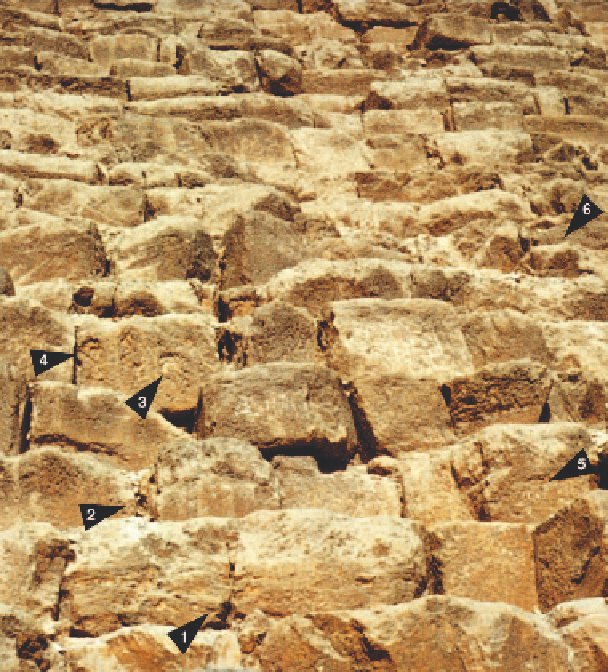Geology Reference
In-Depth Information
Fig. 18.1.
Weathering of the Great Pyra-
mid in Gizeh near Cairo, Egypt.
The
building blocks are almost pure Eocene
limestones of the Mokkatam Group with
only a low quartz and low organic matter
content. The porosity of the material var-
ies between 8.5 and 37.5%; most values
are between 20 and 25%. The limestones
comprise various textural types includ-
ing fossiliferous to sparse wackestones,
skeletal packstones with nummulitid
foraminifera and skeletal packstones to
grainstones. The few samples studied
show no correlation between microfacies,
porosity values and the proportion of pore
throat classes. Relations may exist be-
tween grain fabric, the clay content of
limestones (Rodriguez-Navarro et al.
1997) and weathering types. The photo-
graph shows the lower part of the pyra-
mid. Note the strongly varying weather-
ing types of the dimension stones within
the individual rows. Following Fitzner et
al. (2002) the photograph displays dif-
ferent weathering categories. Fissures
cutting cross-bedding structures (arrows
1, 4), crumbly disintegration (arrow 2),
loss of stone material by backstepping
and breakout (arrow 3) and detachment
of flakes and platy pieces of stones (ar-
rows 5 and 6) are evident. Height of
blocks up to 1 m.
stone monuments (Fitzner and Heinrichs 2001). Based
on monument mapping and the visual inspection of
weathering forms, six damage indices characterizing
subsequent ratings of weathering were distinguished
by Fitzner and Heinrichs (2001):
0 - no visible damage,
I - very slight damage,
II - slight damage,
III - moderate damage,
IV - severe damage,
V - very severe damage.
18.4.2 Preservation
The effect of carbonate stone conservation using
surface sealers penetrating stone consolidants (Perth
et al. 1992; Winkler 1994) or biological agents (Toepfer
1997) can be increased if the texture, porosity and per-
meability of the stones are studied prior to conserva-
tion and restoration (Lorenz 1998).
A case study is explained in Pl. 150. Surface sealing
of stone surfaces aims to prevent the access of mois-
ture. However, pressure may develop behind the seal-
ing by efforescence, crystal growth and/or freezing,
causing new spalling and flaking. Effective conserva-
tion needs the complete drying of the stones followed
by an impregnation that affects all open pores at and
below the surface.
A total impregnation with low viscose methyl-
metacrylate under vacuum pressure conditions in an
autoclave, followed by a thermic treatment causing po-
lymerization and formation of polymethylmetacrylate
has proved to be a very useful method (Acrylic-Total-
Impregnation-Process, Ibach Stone Conservation,
Bamberg).
These categories have been modified and adapted
to specific climatic conditions (Fig. 18.1). Fitzner et
al. (2002) studying ancient Egyptian monuments dis-
tinguished four weathering categories: 1 - loss of stone
material characterized by back weathering, relief and
breakout; 2 - discoloration characterized by the discol-
oration of the original rock color, dirt deposits on stone
surfaces and loose salt deposits, dark crusts; 3 - de-
tachment causing granular or crumbly disintegration,
detachment of flakes and platy larger pieces of stone,
detachment of crusts; and 4 - fissures independent or
dependent of the stone structure.

